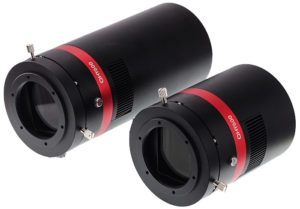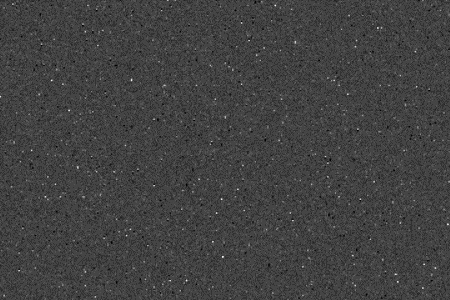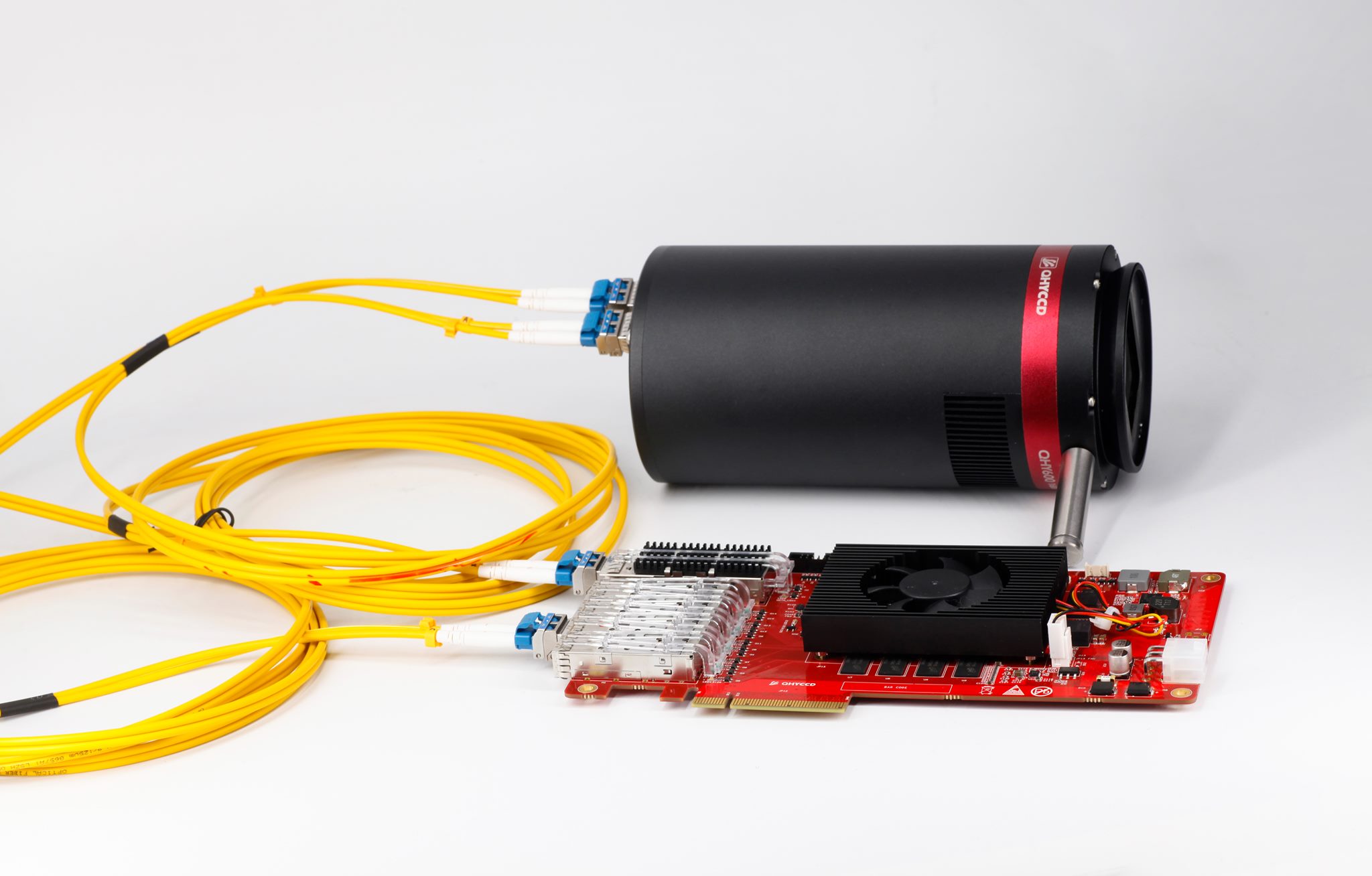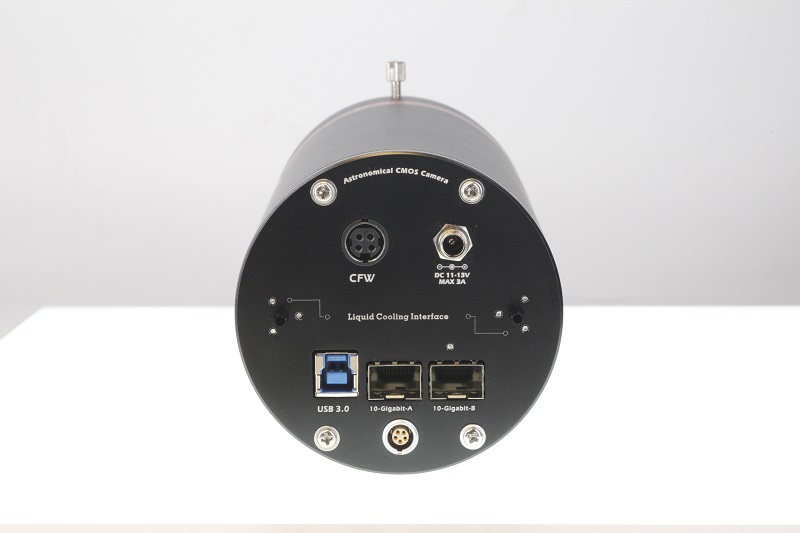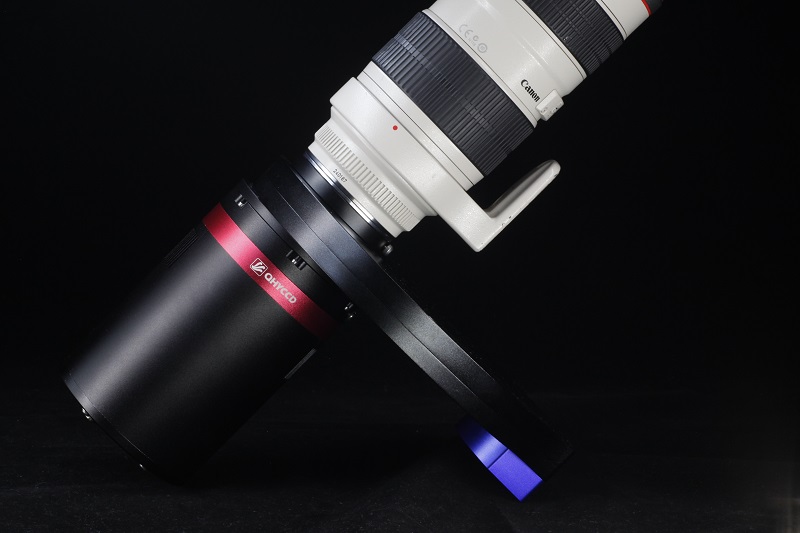QHY600 is a 60 mega Pixel full frame CMOS camera.This sensor is available in both monochrome and color versions
The QHY600 PH, QHY600 PRO and QHY600 PH-L (ite) models are immediately available for pre-order.
The next-generation of high-speed data transmission technology
- USB Re-connection with 12V ON/OFF
- Extended Full Well and Multiple Read Modes
- Random thermal noise suppression
- 2 x 10 Gb optical fiber transmission (QHY600 PRO)
- 1GB / 2GB oversized DDR3 memory
- Large programmable FPGA (EB and PRO), only for QHY600 PRO
Special versions of the QHY 600 models:
- Optional available with additional water cooling (PRO models only)
- Version with short back focus (BFL) available for all QHY 600 models
New Technology Found in QHY600 and QHY268 Cameras:
1. USB Re-Connection with 12V ON/OFF
The QHY600 / 268 camera's USB interface to the computer will connect or disconnect by turning on and off the camera's 12V power, without the need to plug and unplug the USB cable. This technology enhances the controllability of the camera when used in a remote station. You only need to remotely control the 12V power supply of the camera, or the power of the camera AC adapter, to achieve remote USB connecting and reconnecting of the camera.
2. Extended Full Well Capacity and Multiple Read Modes
With a pixel size of 3.76 µm, these sensors already have an impressive full well capacity of 51ke-. Nevertheless, QHYCCD has implemented a unique approach to achieve a full well capacity higher than 51ke- through innovative user controllable read mode settings. In extended full well readout mode, the QHY600 can achieve a much greater full well, more than 80ke- and the QHY268C can achieve approximately 75ke-. Greater full well capacity provides greater dynamic range and large variations in magnitude of brightness are less likely to saturate. The QHY600 / 268C have each have three user controllable readout modes with different characteristics.
3. Random thermal noise suppression
Usually thermal noise in imaging sensors changes with time and temperature in a very reproduceable manner. However, there is another type of thermal noise peculiar to some backilluminated CMOS sensors that has the characteristic of typical fixed pattern noise but the value is not related to the exposure time. Instead, each frame appears to have its own characteristics making dark frame subtraction less effective on the total thermal noise in an image. The QHY600 models / QHY 268 C/M uses an innovative suppression technology that can significantly reduce the level of such random noise.
4. 2 x 10 Gigabit interfacees fpr ultra-high-speed optical fiber transmission
The two professional models of the QHY 600 are prepared for 2 x 10 Gigabit fiber optic interfaces, which can be optionally enabled at extra cost. In addition, a Fiber PCIE Graber Card is required. With Gigabit interfaces, QHY has introduced the next generation of high-speed data transmission technology. This is a revolutionary leap beyond USB 3.0 transmission technology and solves several important shortcomings of USB 3.0 transmission: limited speed, limited distance and reliability.
- Limited Speed
Although USB 3.0 is quite fast it still cannot fully meet the maximum speed requirements of the latest generation of CMOS image sensors used in the QHY600 PRO models. For example, the IMX455 chip used in the QHY600 can produce four 16-bit, 60 Megapixel frames per second. In this case, the amount of data transferred per second is 120 * 4 = 480MB and the real-world maximum transmission speed via USB3.0 can is generally not much more than 300 MB/s. Via the USB 3.0 interface, image transfer is limited to 2.5 frames per second. In contrast, a transfer speed of up to 2000 Mb/s can be achieved via the 2 x 10 Gbp/s fiber optic interfaces. - Limited Distance
USB 3.0 transmission is generally stable over a limited distance of about 2-3 meters. An active extension cable is usually required for more than 3 meters but even with an active extension the cable may only reach about 15 meters. However, transmission over optical fiber can easily be done at distances up to 300 meters (remote operation !). - Stable transmission without electromagnetic interference
As we know, the propagation of light is not affected by electromagnetic radiation, so transmission through optical cables has very high reliability. There is no conductive medium between the camera and the computer, so it is not affected by various sources of static or leakage effects.
Note: Free switching and upgrading to the fiber optic interfaces is also possible at a later date for the earlier models QHY 600 - Early Bird (EB) and the QHY 600 - PRO - L.
5. 1GB / 2GB oversized DDR3 memory
The extremely large number of individual pixels of the latest generation of CMOS sensors leads to increased memory requirements, both for temporary intermediate storage and permanent storage on the computer. For example, the QHY600 Sony IMX 455 sensor produces about 120MB of data per frame. Transferring such a large file sizes necessarily requires the camera to have sufficient memory. The QHY600 models / QHY 268 C/M has adopted a large-capacity memory of up to 1GB (QHY600 PH-L/ QHY 268) and 2GB (QHY600 PRO). This large image buffer meets the needs of high-speed image acquisition and transmission of the new generation of CMOS sensors, making capture of multiple frames smoother and less stuttered, further reducing the pressure on the computer CPU!
6. FPGA – Large-capacity flexible hardware programmable technology
The QHY600 mdoels and QHY268 C/M has a million-gate, 20nm process programmable Field Programmable Gate Array chip. The camera firmware itself only occupies 10% of the resources, so 90% of the hardware logic resources can provide users with many custom functions. In the QHY600 PRO model and QHY268 C/M these functions include high-performance GPS trigger imaging, hardware time stamp, high-precision external trigger, continuous mode with latent image elimination, two readouts to reduce readout noise and multi-camera high-precision synchronous shooting and so on to meet a variety of complex application needs.
Special versions of the QHY 600 models
A Optional water-cooling
QHYCCD accepts orders for QHY600 PRO cameras customized for water-cooling. The water cooling must be firmly ordered with an order, a later retrofit is NOT possible. Compared with air cooling, water cooling has the following important advantages:
- No vibration. Air-cooling requires the use of a fan inside the camera that may induce small vibrations. Even the highest quality fan cannot avoid some effect on the FWHM (full width at half maximum) of stellar images on certain telescopes. Long focal length optical systems are more sensitive to this effect. However, water cooling achieves temperature reduction through the slow flow of water. There is no moving mechanical component to cause vibration of the camera, eliminating any negative effect on the image.
- No hot air turbulence. For optical systems like RASA and Hyperstar where the camera is placed at the secondary position, air turbulence is not generated. When an air-cooled camera is installed infront of the optics, the hot air generated by the air-cooled system passes through the optical path and can generate seeing effects. Water cooling does not produce hot air discharge. The heat is carried away by the liquid so there is no such effect.
- Greater Cooling Delta T. With water cooling, the maximum cooling temperature is about 10 degrees Celsius lower than the maximum temperature achieved with air only. This has a particularly positive effect for long exposures and when used under tropical night temperatures.
B Short back-focus version
 All three QHY models (PRO, PHOTO and LITE) are also available as short back focus (BFL) versions. Here, the backfocus is only 7mm, instead of the usual 17.5mm, behind the camera body. They are specially designed for the adaptation of Canon and Nikon lenses. An off-axis guider and filter wheels can be integrated. More information at QHYCCD about the BFL version can be found here.
All three QHY models (PRO, PHOTO and LITE) are also available as short back focus (BFL) versions. Here, the backfocus is only 7mm, instead of the usual 17.5mm, behind the camera body. They are specially designed for the adaptation of Canon and Nikon lenses. An off-axis guider and filter wheels can be integrated. More information at QHYCCD about the BFL version can be found here.
In order to meet the limited back-focus requirements of certain optical configurations of filter wheel and lens or for instruments such as spectrometers, etc., the QHY600 models are also available in a short back-focus version. Here the distance between telescope mount and sensor plane is only 7mm. This custom version requires advance booking. This version also provides a solution for chip tilt adjustment, in order to be able to correct a possible tilting of the sensor plane against the telescope optical path. However, because the glass window of the short back-focus version is closer to the CMOS chip, the risk of condensation is greater than the standard version with 17,5mm even though the sealed window glass heating plate is also integrated. QHYCCD provides a corresponding solution to this situation. Nevertheless, it is recommended that users without such special requirements choose the standard version.

